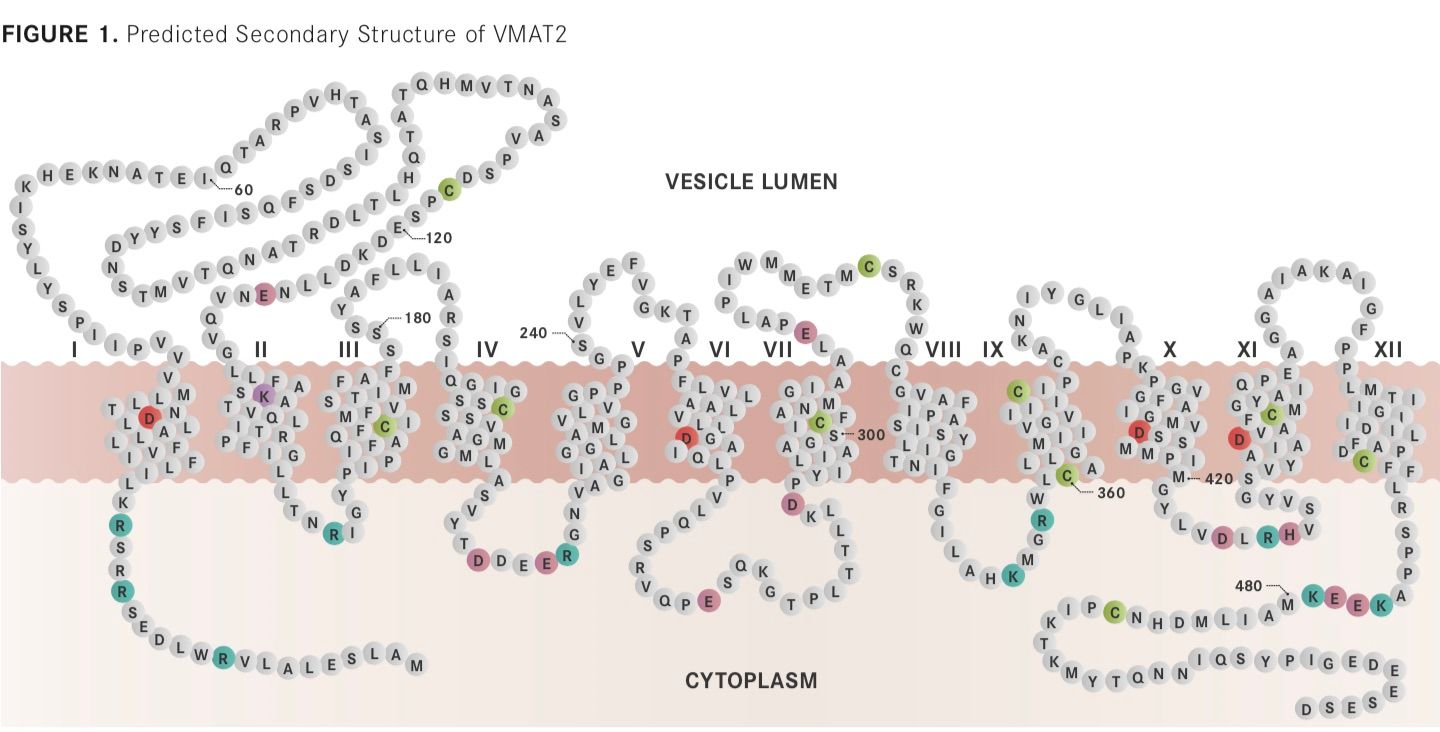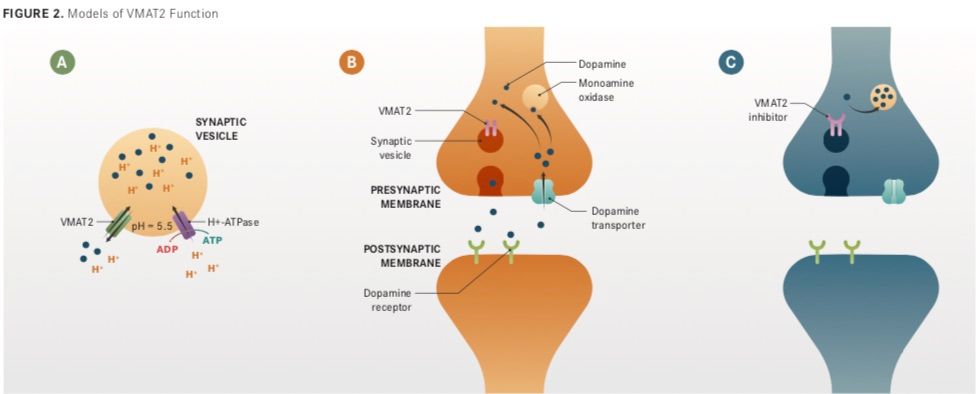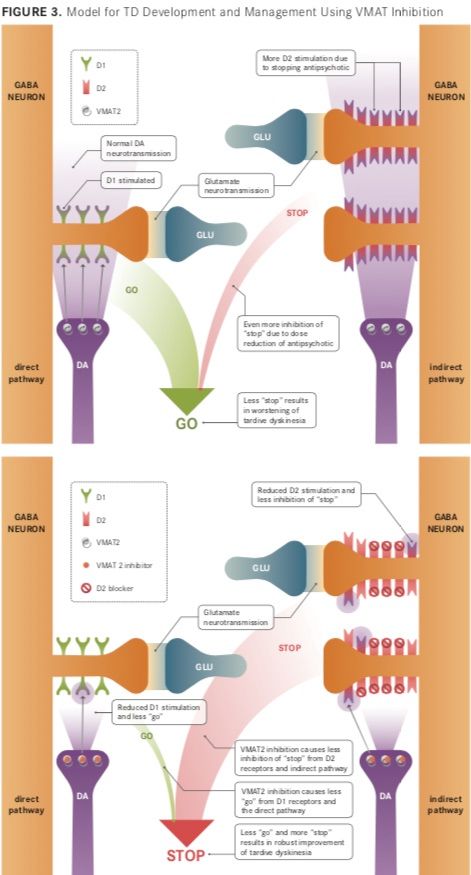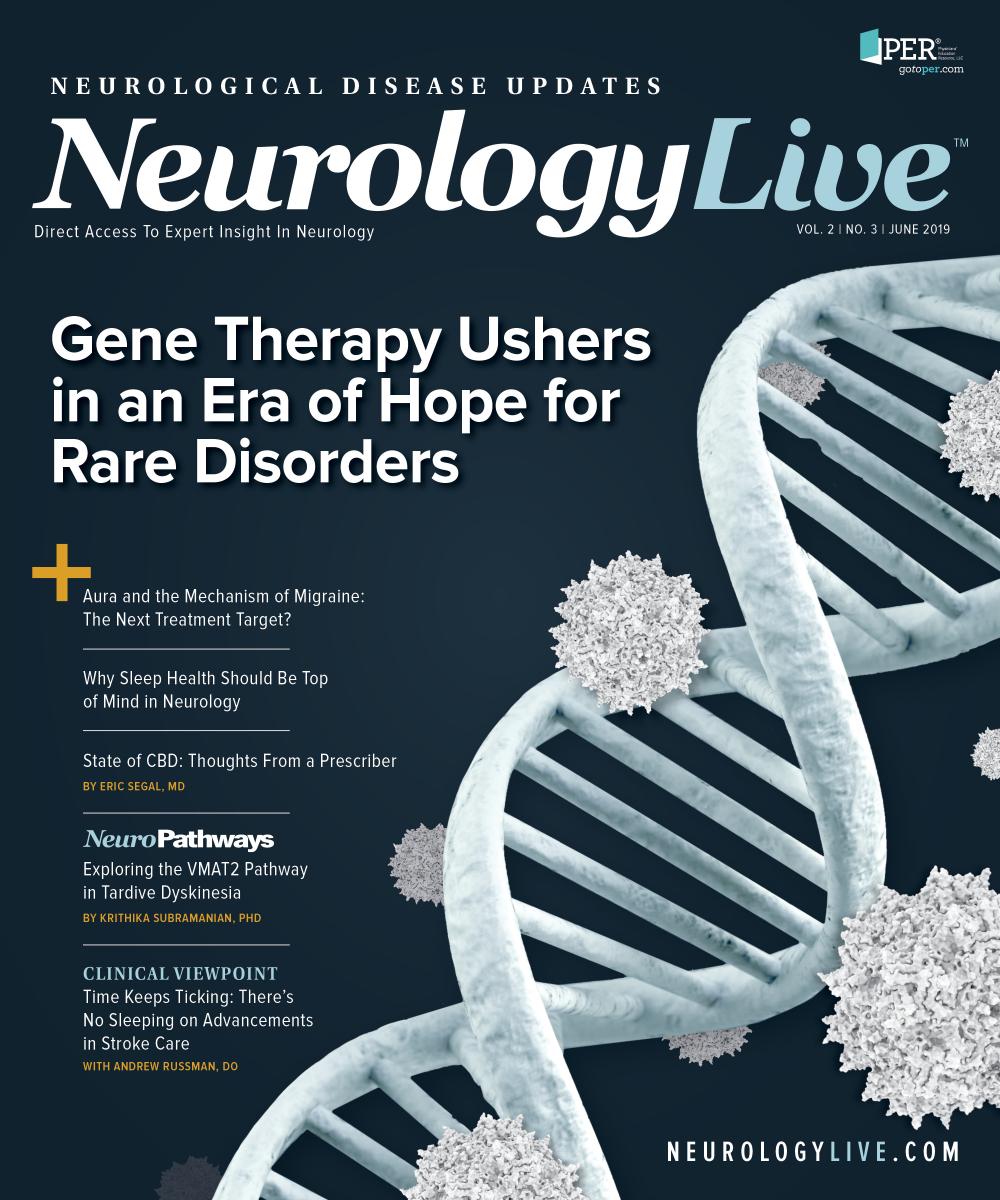Publication
Article
NeurologyLive
Exploring the VMAT2 Pathway in Tardive Dyskinesia
Author(s):
VMAT2, given its role in presynaptic packaging, storage, and release of dopamine, has emerged as a promising target for therapeutic interventions to manage movement disorders.

Classical synaptic transmission, the primary mode of communication between the synaptic and postsynaptic neurons, involves the release of neurotransmitters from the presynaptic cell into the synaptic cleft, followed by the interaction of the neurotransmitter with receptors on the postsynaptic cell, leading to signal transduction.1,2 The active removal of the neurotransmitter from the synaptic cleft by sodium-coupled transporters, and the subsequent removal of neurotransmitters from the cytoplasm and storage in secretory vesicles by vesicular neurotransmitter transporters, terminate the synaptic signal.1
Investigators have identified several types of vesicular neurotransmitter transporters, including transporters for γ-amino butyric acid, glutamate, glycine, acetylcholine, and monoamines.3 Vesicular monoamine transporters (VMATs) are the primary mediators of the uptake and sequestration of monoamine neurotransmitters, including dopamine, serotonin, and histamine, in vesicles prior to subsequent Ca2+-stimulated exocytotic release.2,4 Defective or aberrant functioning of dopamine transporters or VMATs profoundly alters the intra- and extracellular concentrations of neurotransmitters.5
Monoaminergic neuronal dysfunction is associated with neurologic and psychiatric disorders such as Parkinson disease (PD), attention-deficit hyperactivity disorder, Huntington disease (HD), depression, and movement disorders.2,4,5 Two isoforms of VMAT exist in mammals, VMAT1 and 2, which are homologous members of the solute carrier 18 (SLC18) family of transporters, a subfamily of the major facilitator superfamily, and are encoded by separate genes.1,4,6 SLC18 is the largest family of secondary active membrane transporters, which includes antiporters, symporters, and uniporters.1 VMAT1 (SLC18A1) is expressed exclusively in neuroendocrine cells in the periphery, with expression reported in the sympathetic nervous system, adrenal chromaffin cells, and endocrine/paracrine cells of the gut.1,2,4 VMAT2 (SLC18A2) is expressed in monoaminergic neurons in the peripheral, central, and enteric nervous systems; notably, VMAT2 is expressed in all monoaminergic neurons of the brain.2,4 VMATs have similar structures and share common substrates, with the exception of histamine, which is packaged exclusively by VMAT2. VMAT2 also demonstrates higher affinity for catecholamines.7-9 In addition to its natural substrates, VMAT2 can transport certain drugs as “false” substrates; these drugs, such as amphetamine and methylenedioxymethamphetamine, can act as competitors to the natural neurotransmitter.3
VMATs have been shown to play a crucial role not only in sorting, storage, and release of neurotransmitters but also in modulating the neuronal and endocrine informational output.6 Given their critical functions in monoaminergic signaling pathways, VMATs have gained interest as potential therapeutic targets for modulating monoamine homeostasis in disorders characterized by disruption or aberrant functioning of monoaminergic systems.2,4
VMAT2 Pathway
VMAT2 is an acidic transmembrane glycoprotein, and primary amino acid sequence analyses predict the presence of 12 transmembrane domains, cytosolic C- and N-termini, and a large glycosylated intraluminal loop between the first and second transmembrane regions (Figure 1).2,6 The significance of VMAT2 in neuronal monoaminergic signaling is highlighted by the high degree of conservation of the VMAT2 amino acid sequence across mammals; VMAT2 protein exhibits 96% sequence homology between rats and mice and 92% sequence homology between rats and humans.5

VMAT2 is localized predominantly on small synaptic vesicles in the central nervous system, with some VMAT2 also detected in dense-core vesicles.2 On the synaptic vesicles of the presynaptic terminal, VMAT2 acts as a stoichiometric H+—ATPase antiporter, using the energy from ATP hydrolysis to transport H+ into vesicles, thereby creating an acidic environment inside the vesicle (Figure 2).2,6 This proton transfer generates the electrochemical gradient necessary for VMAT2-mediated monoamine transfer into vesicles.2,6 For every molecule of monoamine transported into the vesicular lumen, 2 protons are estimated to be transferred out of the vesicle and into the cytosol.6 The efflux of the first proton is proposed to facilitate a transporter conformation with a high-affinity amine-binding site in the cytosolic phase, whereas the efflux of the second proton is coupled with a conformational change that promotes amine transfer from the cytosol to the matrix, with a concomitant decrease in amine-binding affinity (Figure 2).6 Inhibition of VMAT2, such as with tetrabenazine (TBZ; Xenazine),10 deutetrabenazine (DTBZ; Austedo),11 or valbenazine (Ingrezza),12 preferentially blocks dopamine uptake into synaptic vesicles and depletes dopamine in the presynaptic terminal via cytosolic monoamine oxidase activity, essentially reducing monoamine storage and release (Figure 2).5,13,14
The Role of VMAT2 in Tardive Dyskinesia
As noted above, dysregulation of dopamine neurotransmission contributes to the pathogenesis of many nervous and psychiatric disorders, including PD, HD, and movement disorders.2,15 Dopaminergic hyperactivity has been linked to hyperkinetic movement disorders, such as tics, tremors, and chorea, whereas hypoactivity of dopaminergic signaling is associated with hypokinetic movement disorders, such as those in PD.2 VMAT2, given its role in presynaptic packaging, storage, and release of dopamine, has emerged as a promising target for therapeutic interventions to manage movement disorders. Indeed, VMAT2 inhibitors have been used for treatment of such disorders for many years and were available under a compassionate use, open-label protocol at a limited number of centers for over 30 years.14
In particular, VMAT2 inhibitors may be of use in treatment of tardive dyskinesia (TD) and movement-associated adverse effects (AEs) of antipsychotics and other dopamine receptor blockers.2,14 Indeed, following the regulatory approval of 2 VMAT2 inhibitors, dTBZ16 and valbenazine17 by the FDA, these agents are now considered the mainstay of treatment for TD.13 Targeting vesicular transporters, rather than receptors or plasma membrane transporters, offers some advantages; a review of the role of VMAT2 as a pharmacologic target states that “direct targeting of the vesicle, alone or in combination with existing therapies, may allow for modulation of neurotransmission while maintaining the proper kinetics of exocytotic [dopamine] release and termination of the signal,” rather than allowing for temporary suppression of endogenous dopaminergic signaling, concomitant with increased risk of compensatory regulatory mechanisms.4

The tardive form of dyskinesia gets its name from the slow, or tardive, onset of involuntary hyperkinetic movements of the face, lips, tongue, trunk, and extremities.18,19 In TD, persistent iatrogenic movement disorders are evident secondary to exposure to dopamine receptor—blocking agents (DRBAs), such as antipsychotic medications, but also other medications, such as tricyclic antidepressants and antiemetics.13,19 The Diagnostic and Statistical Manual of Mental Disorders, Fifth Edition, defines TD as ‘‘involuntary athetoid or choreiform movements (lasting at least a few weeks) generally of the tongue, lower face and jaw, and extremities (but sometimes involving the pharyngeal, diaphragmatic, or trunk muscles) developing in association with the use of a neuroleptic medication for at least a few months.’’20
Although the pathophysiology of TD has not been characterized completely, chronic blockade of dopamine receptors and resultant dopamine hypersensitivity are thought to underlie TD development.3,19 In a recent review,3 Stahl proposed a model for TD as an imbalance between the “stop” and “go” signals from the motor striatum (Figure 3).3 In this model, dopamine hypersensitivity leads to hyperinhibition of the stop signals from the upregulated dopamine-stimulated dopamine receptor 2 (D2), in conjunction with unopposed go signals, thus generating the hyperkinetic movements observed in TD.3 In this context, inhibition of VMAT2 lowers dopamine stimulation without blocking dopamine receptors, which has demonstrated efficacy in the short term for some patients with TD but at the expense of AEs and worsening of TD longer term.21 A model for VMAT2 inhibition—mediated modulation of both indirect (stop) and direct (go) signaling pathways to reduce involuntary hyperkinetic movements was described in the review by Stahl (Figure 3).3 Stahl noted that “VMAT2 inhibition can ‘train’ motor pathways of TD to compensate for their abnormal ‘learning’ after chronic D2 receptor blockade.” The effect of VMAT2 inhibition on TD in the long term and its ability to treat TD rather than transiently reverse symptoms require further study, Stahl added.
VMAT Inhibitors
Three VMAT2 inhibitors have been described historically, the 2 naturally occurring alkaloids reserpine and lobeline and the synthetic compound TBZ.2 Unlike reserpine, TBZ is a VMAT2-selective reversible inhibitor that acts at a site that is distinct from the substrate-binding site of VMAT2.6,22 The inhibitor effect of TBZ on VMAT2 is significantly more potent than on VMAT1 (IC50 of 0.3 μM for VMAT2 vs 3.0 μM for VMAT1).22 Lobeline acts at the same site as TBZ to decrease amphetamine-evoked dopamine release, suggesting that lobeline selectively inhibits amphetamine effects; VMAT2 inhibition by lobeline has recently regenerated interest as a therapeutic strategy in treatment of psychostimulant abuse.2,22 Originally approved in 1958 for the treatment of neuroses and psychoses in schizophrenia, TBZ use subsequently became limited with the discovery of more efficacious DRBAs, like phenothiazines.23 In the past 2 decades, TBZ has been used in a multitude of movement disorders, including TD, dystonia, and tremor and tic disorders.23 A deuterated form of TBZ, dTBZ, and valbenazine are 2 other VMAT2 inhibitors of interest in the management of TD; the latter 2 have been approved by the FDA for the treatment of TD.14,16,17,24
High first-pass metabolism of TBZ generates the metabolites α-dihydrotetrabenazine (active) and β-dihydrotetrabenazine (biochemically inert), with 4- to 8-hour and 2- to 4-hour half-lives, respectively, requiring dosing 3 times daily.14 In dTBZ, deuterium atoms replace the hydrogen atoms on the 2 methoxy groups of TBZ. The carbon—deuterium bond undergoes oxidative metabolism approximately 10 times slower than the carbon–hydrogen bond, leading to slower degradation of the active metabolites and a longer half-life, without altering protein interactions; the longer half-life allows for twice-daily dosing.11,14,25 Valbenazine is metabolized more slowly than TBZ and dTBZ, with a half-life of 15 to 22 hours; valbenazine and its metabolites reach a steady state approximately 8 days after the initiation of medication.14

Utilizing VMAT2 Inhibitors
Valbenazine and dTBZ have been evaluated in several trials in patients with TD for efficacy and safety24; in contrast, despite support for efficacy of TBZ in TD from some studies, TBZ has not been formally studied for this indication, and TD is not listed on the package label.
The KINECT study included subjects with schizophrenia or schizoaffective disorder, with untreated neuroleptic-induced TD for at least 3 months, and receiving a stable dose of antipsychotic medication for a minimum of 30 days before the study’s start, or with stable psychiatric status.24 The study had 3 treatment arms: placebo for 6 weeks; valbenazine (50 mg) daily for 6 weeks; or valbenazine (100 mg) daily for 2 weeks, followed by valbenazine (50 mg) daily for 4 weeks. The change in AIMS [Abnormal Involuntary Movement Scale] scores from baseline to 6 weeks did not differ significantly between the treatment and placebo groups when assessed by an on-site rater (—3.3 vs –2.5, respectively; P >.05), but an assessment by blinded central video rater found a significant difference (—3.3 vs –1.5, respectively; P = .03).24,26 In the KINECT extension study, a mean change of —5.8 on AIMS was observed, and 61% of patients were assessed to be “much improved” or “very much improved,” according to their Clinical Global Impression–Tardive Dyskinesia (CGI-TD) score.27 The AIMS change from baseline differed significantly (–2.6 vs –0.2 least squares mean change; P =.0005) between the treatment and placebo groups in the KINECT 2 study, and 67% of valbenazine-treated patients were assessed as “very much improved” or “much improved” versus 16% of the placebo group (P <.0001), according to CGI-TD score.28 In the KINECT 3 study, patients received either placebo or valbenazine (40 mg or 80 mg daily); the data indicated a significant difference in degree of TD symptom reduction between the placebo group (AIMS score change at 6 weeks, —0.1) and both the 40-mg (AIMS change, –1.9; P =.002) and 80-mg valbenazine groups (AIMS change, —3.2; P <.001). Although the CGI-TD scores did not differ among groups, subgroup analyses suggested significant improvement in those subjects with detectable plasma levels of valbenazine at week 6.29 The KINECT 3 extension study found significant reductions in mean AIMS scores, as well as clinically significant improvements, as indicated by decreases in CGI-TD and Patient Global Impression of Change scores, in both the 40-mg and 80-mg treatment groups.30 A more recent pooled, ad hoc analysis of data from the long-term exposure population of the KINECT, KINECT 3, and KINECT 4 studies indicated that valbenazine was well tolerated in adults with TD who received up to 48 weeks of treatment.31
The ARM-TD study demonstrated an improvement in AIMS score of 3.0 points for the dTBZ group versus 1.6 points for placebo (P = .019), with an average baseline score of 9.6 in both groups. Incidence of AEs, including psychiatric AEs, was comparable between the placebo and dTBZ arms of the study.32 In the AIM-TD study, at 12 weeks, the AIMS score improvements ranged from 2.1 points (in the 12-mg/day dTBZ group) to 3.2 and 3.3 (in the 24-mg/day and 36-mg/day dTBZ groups, respectively) versus 1.4 points in the placebo group, constituting a statistically significant net reduction (22%-34%) in AIMS score (baseline scores, 9.4-10.1) in the 36-mg/day and 24-mg/day groups but not in the 12-mg/day group.33 AEs occurred at a rate comparable with those for placebo.
Taken together, these studies indicate that dTBZ and especially valbenazine are effective in TD management, even against the background of continuation of baseline neuroleptics or underlying psychiatric diagnosis of schizophrenia/schizoaffective disorder or mood disorder.14,24,34 Consideration for selection of a specific VMAT2 inhibitor would include ease of administration and compliance, as well as the differing metabolic pathways, which may impinge on additional effects on dopaminergic/serotonergic receptors.14 In the latter context, valbenazine, because of its selectivity for VMAT2, may reduce the risk of monoamine deficiency syndrome, with symptoms including irritability, anxiety, apathy, somnolence, and cognitive slowing, which have been described with long-term use of psychiatric medications.14,35 Also, although the recommended dosing of TBZ is 3 times per day, dTBZ is dosed twice per day and valbenazine only once per day; in practical terms, the once-daily dosage with valbenazine may offer advantages in medication adherence and ease of use from a patient perspective.
On the other hand, although TBZ and dTBZ doses can be titrated in small increments relative to their maximal dose, only 2 dosage strengths for valbenazine (40 mg and 80 mg) are available currently, with 80 mg being the maximum recommended dose.14 In general, dTBZ and valbenazine have more favorable AE profiles than TBZ, likely relating to their improved pharmacokinetic profiles.
Looking Ahead
To date, 3 VMAT2 inhibitors have gained regulatory approval in the United States; a recent review noted that the “prescribing environment [of VMAT2 inhibitors] is actively changing” because of expansion of indications for these agents in neuropsychiatric disorders and the more favorable AE profiles of dTBZ and valbenazine.14 These advantages may help counterbalance their limited use in the past due to the high cost of medication along with limited familiarity with VMAT2 inhibitors outside specialized movement disorder centers, noted the authors.14 The authors anticipated expansion of VMAT2 inhibitors in management of Tourette syndrome symptoms, especially “in late adolescent or adult patients where the development of TD with ongoing DRBD [dopamine receptor—blocking drug] use is of particular concern.”14 The development of VMAT2 inhibitors represents an important advancement in treatment of movement disorders. With additional data from long-term studies of this class of drugs in representative patient populations,36 clinical evidence from real-world utilization and comparisons of VMAT2 inhibitors,35,36 an increased understanding of the genetic and pathophysiological underpinnings of TD development,37,38 and improved awareness of TD in patients receiving DRBAs and its appropriate management with VMAT2 inhibitors, the path to management of TD is being paved for the future.
REFERENCES
1. Yaffe D, Forrest LR, Schuldiner S. The ins and outs of vesicular monoamine transporters. J Gen Physiol. 2018;150(5):671-682. doi: 10.1085/jgp.201711980.
2. Harriott ND, Williams JP, Smith EB, Bozigian HP, Grigoriadis DE. VMAT2 inhibitors and the path to Ingrezza (valbenazine). Prog Med Chem. 2018;57(1):87-111. doi: 10.1016/bs.pmch.2017.12.002.
3. Stahl SM. Mechanism of action of vesicular monoamine transporter 2 (VMAT2) inhibitors in tardive dyskinesia: reducing dopamine leads to less “go” and more “stop” from the motor striatum for robust therapeutic effects. CNS Spectr. 2018;23(1):1-6. doi: 10.1017/S1092852917000621.
4. Bernstein AI, Stout KA, Miller GW. The vesicular monoamine transporter 2: an underexplored pharmacological target. Neurochem Int. 2014;73:89-97. doi: 10.1016/j.neuint.2013.12.003.
5. German CL, Baladi MG, McFadden LM, Hanson GR, Fleckenstein AE. Regulation of the dopamine and vesicular monoamine transporters: pharmacological targets and implications for disease. Pharmacol Rev. 2015;67(4):1005-1024. doi: 10.1124/pr.114.010397.
6. Wimalasena K. Vesicular monoamine transporters: structure-function, pharmacology, and medicinal chemistry. Med Res Rev. 2011;31(4):483-519. doi: 10.1002/med.20187.
7. Peter D, Jimenez J, Liu Y, Kim J, Edwards RH. The chromaffin granule and synaptic vesicle amine transporters differ in substrate recognition and sensitivity to inhibitors. J Biol Chem. 1994;269(10):7231-7237.
8. Erickson JD, Schafer MK, Bonner TI, Eiden LE, Weihe E. Distinct pharmacological properties and distribution in neurons and endocrine cells of two isoforms of the human vesicular monoamine transporter. Proc Natl Acad Sci U S A. 1996;93(10):5166-5171. doi: 10.1073/pnas.93.10.5166.
9. Schafer MK-H, Weihe E, Eiden LE. Localization and expression of VMAT2 [across] mammalian species: a translational guide for its visualization and targeting in health and disease. Adv Pharmacol. 2013;68:319-334. doi: 10.1016/B978-0-12-411512-5.00015-4.
10. Xenazine (tetrabenazine) [package insert]. Deerfield, IL: Valeant Pharmaceuticals North America LLC/Lundbeck; 2018. lundbeck.com/upload/us/files/pdf/Products/Xenazine_PI_US_EN.pdf. Accessed May 1, 2019.
11. Austedo (deutetrabenazine) [package insert]. North Wales, PA: Teva Pharmaceuticals USA; 2017. austedo.com/globalassets/austedo/prescribing-information.pdf. Accessed May 1, 2019.
12. Ingrezza (valbenazine) [package insert]. San Diego, CA: Neurocrine Biosciences; 2018. ingrezza.com/PI. Accessed May 1, 2019.
13. Niemann N, Jankovic J. Treatment of tardive dyskinesia: a general overview with focus on the vesicular monoamine transporter 2 inhibitors [erratum in Drugs. 2018;78(5):609. doi: 10.1007/s40265-018-0893-7]. Drugs. 2018;78(5):525-541.
14. Tarakad A, Jimenez-Shahed J. VMAT2 inhibitors in neuropsychiatric disorders. CNS Drugs. 2018;32(12):1131-1144. doi: 10.1007/s40265-018-0874-x.
15. Dickey AS, La Spada AR. Therapy development in Huntington disease: from current strategies to emerging opportunities. Am J Med Genet A. 2018;176(4):842-861. doi: 10.1002/ajmg.a.38494.
16. FDA OKs deutetrabenazine (Austedo) for tardive dyskinesia. Medscape website. medscape.com/viewarticle/885051. Accessed May 2, 2019.
17. FDA approves first drug to treat tardive dyskinesia [news release]. Silver Spring, MD: FDA; April 11, 2017; www.fda.gov/news-events/press-announcements/fda-approves-first-drug-treat-tardive-dyskinesia. Accessed May 2, 2019.
18. Cornett EM, Novitch M, Kaye AD, Kata V, Kaye AM. Medication-induced tardive dyskinesia: a review and update. Ochsner J. 2017;17(2):162-174.
19. Waln O, Jankovic J. An update on tardive dyskinesia: from phenomenology to treatment. Tremor Other Hyperkinet Mov (N Y). 2013;3. doi: 10.7916/D88P5Z71.
20. American Psychiatric Association. Medication-induced movement disorders and other adverse effects of medication. In: Diagnostic and Statistical Manual of Mental Disorders. 5th ed. DSM Library; 2013.
21. Caroff SN, Campbell EC. Drug-induced extrapyramidal syndromes: implications for contemporary practice. Psychiatr Clin North Am. 2016;39(3):391-411. doi: 10.1016/j.psc.2016.04.003.
22. Lohr KM, Masoud ST, Salahpour A, Miller GW. Membrane transporters as mediators of synaptic dopamine dynamics: implications for disease. Eur J Neurosci. 2017;45(1):20-33. doi: 10.1111/ejn.13357.
23. Paleacu D. Tetrabenazine in the treatment of Huntington’s disease. Neuropsychiatr Dis Treat. 2007;3(5):545-551.
24. Touma KTB, Scarff JR. Valbenazine and deutetrabenazine for tardive dyskinesia. Innov Clin Neurosci. 2018;15(5-6):13-16.
25. Dean M, Sung VW. Review of deutetrabenazine: a novel treatment for chorea associated with Huntington’s disease. Drug Des Devel Ther. 2018;12:313-319. doi: 10.2147/DDDT.S138828.
26. Müller T. Valbenazine for the treatment of tardive dyskinesia. Expert Rev Neurother. 2017;17(12):1135-1144. doi: 10.1080/14737175.2017.1386556.
27. Jimenez R, Shiwach R, Bari M, O’Brien C. Twelve-week treatment of tardive dyskinesia with NBI-98854. Mov Disord. 2014;29:304-305.
28. O’Brien CF, Jimenez R, Hauser RA, et al. NBI-98854, a selective monoamine transport inhibitor for the treatment of tardive dyskinesia: a randomized, double-blind, placebo-controlled study. Mov Disord. 2015;30(12):1681-1687. doi: 10.1002/mds.26330.
29. Hauser RA, Factor SA, Marder SR, et al. KINECT 3: a phase 3 randomized, double-blind, placebo-controlled trial of valbenazine for tardive dyskinesia. Am J Psychiatry. 2017;174(5):476-484. doi: 10.1176/appi.ajp.2017.16091037.
30. Factor SA, Remington G, Comella CL, et al. The effects of valbenazine in participants with tardive dyskinesia: results of the 1-year KINECT 3 extension study. J Clin Psychiatry. 2017;78(9):1344-1350. doi: 10.4088/JCP.17m11777.
31. Josiassen RC, Kane JM, Liang GS, Burke J, O’Brien CF. Long-term safety and tolerability of valbenazine (NBI-98854) in subjects with tardive dyskinesia and a diagnosis of schizophrenia or mood disorder. Psychopharmacol Bull. 2017;47(3):61-68.
32. Fernandez HH, Factor SA, Hauser RA, et al. Randomized controlled trial of deutetrabenazine for tardive dyskinesia: the ARM-TD study. Neurology. 2017;88(21):2003-2010. doi: 10.1212/WNL.0000000000003960.
33. Anderson KE, Stamler D, Davis MD, et al. Deutetrabenazine for treatment of involuntary movements in patients with tardive dyskinesia (AIM-TD): a double-blind, randomised, placebo-controlled, phase 3 trial. Lancet Psychiatry. 2017;4(8):595-604. doi: 10.1016/S2215-0366(17)30236-5.
34. Citrome L. Valbenazine for tardive dyskinesia: a systematic review of the efficacy and safety profile for this newly approved novel medication—what is the number needed to treat, number needed to harm and likelihood to be helped or harmed? Int J Clin Pract. 2017;71(7). doi: 10.1111/ijcp.12964.
35. Niemann N, Jankovic J. Real-world experience with VMAT2 inhibitors. Clin Neuropharmacol. 2019;42(2):37-41. doi: 10.1097/WNF.0000000000000326.
36. Caroff SN, Aggarwal S, Yonan C. Treatment of tardive dyskinesia with tetrabenazine or valbenazine: a systematic review. J Comp Eff Res. 2018;7(2):135-148. doi: 10.2217/cer-2017-0065.
37. Zai CC, Maes MS, Tiwari AK, Zai GC, Remington G, Kennedy JL. Genetics of tardive dyskinesia: Promising leads and ways forward. J Neurol Sci. 2018;389:28-34. doi: 10.1016/j.jns.2018.02.011.
38. Zai CC, Lee FH, Tiwari AK, et al. Investigation of the HSPG2 gene in tardive dyskinesia - new data and meta-analysis. Front Pharmacol. 2018;9:974. doi: 10.3389/fphar.2018.00974.






